Amidst the ongoing feud between the Palace and Prince Harry and Meghan Markle, a new controversy has emerged surrounding their daughter’s name, Princess Lilibet. Contrary to the couple’s claims that Queen Elizabeth II supported the use of her childhood nickname for their newborn, a royal author has recently revealed that the Queen was actually furious about it. In this article, we delve into the details of this naming dispute and explore its implications for the strained relationship between the Duke and Duchess of Sussex and the royal family.
A Secret Extract Unveils the Queen’s Anger
Renowned author Robert Hardman, in a bombshell extract from his latest biography titled “Charles III: New King. New Court. The Inside Story,” has shed light on Queen Elizabeth II’s true feelings regarding Princess Lilibet’s name. Hardman discloses that the Queen was the angriest he had ever seen her, debunking Harry and Meghan’s claims of her support. This revelation aligns with BBC’s royal correspondent Jonny Dymond’s statement, where he confirmed that the couple never sought permission from the Queen before naming their daughter Lilibet.
The Last Straw for the Queen
Adding fuel to the fire, a report by the Daily Mail corroborates the claims made by Hardman’s book. According to an anonymous source, the Queen was already frustrated with the fact that she did not have full ownership of her own palaces or paintings. The naming of Princess Lilibet, who shares the Queen’s iconic nickname, was perceived by Her Majesty as a further encroachment on the one thing she believed she truly owned – her name. The report suggests that the Queen expressed her dismay, stating, “‘I don’t own the palaces, I don’t own the paintings, the only thing I own is my name. And now they’ve taken that.”
While the Queen was taken aback by Harry’s intention to name his daughter Lilibet, she found herself in a difficult position. Despite her reservations about the choice of name, the Queen felt obliged to remain silent and not publicly oppose the decision. This uncomfortable stance highlights the delicate dynamics within the royal family and the constraints imposed upon its members, even the reigning monarch.
Continued Estrangement
The naming controversy surrounding Princess Lilibet is just the latest episode in the ongoing estrangement between Prince Harry, Meghan Markle, and the rest of the royal family. The strained relationship has been marred by frequent clashes and public spats. It is no surprise that this new revelation adds another layer to the already deep divisions between the Sussexes and the institution they have sought to distance themselves from.
Shakespeare famously wrote, “What’s in a name?” In the case of Queen Elizabeth II, it seems her name holds immense significance. Throughout her reign, the Queen’s name has become synonymous with her identity, authority, and legacy. The use of her childhood nickname for Princess Lilibet by Harry and Meghan is seen by some as an appropriation of the Queen’s personal and historical connection to her name. This choice inevitably invites speculation about the motivations behind it, further straining the already tenuous relationship between the Sussexes and the royal family.
As the controversy surrounding Princess Lilibet’s name continues to unfold, it remains to be seen how the Duke and Duchess of Sussex will respond to this latest claim. With tensions still high, any pushback from Harry and Meghan may lead to further escalation of conflicts. Regardless of the outcome, this naming controversy serves as a stark reminder of the complex power dynamics within the royal family and the near-impossible balancing act faced by the Queen herself.







Leave a Reply